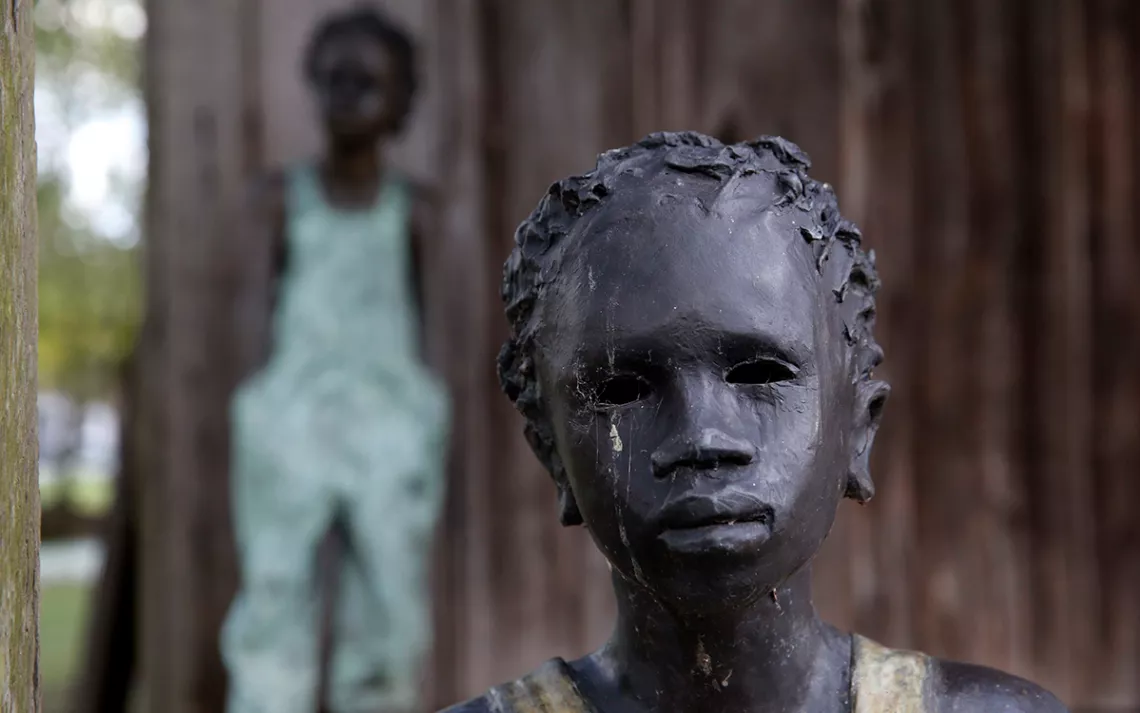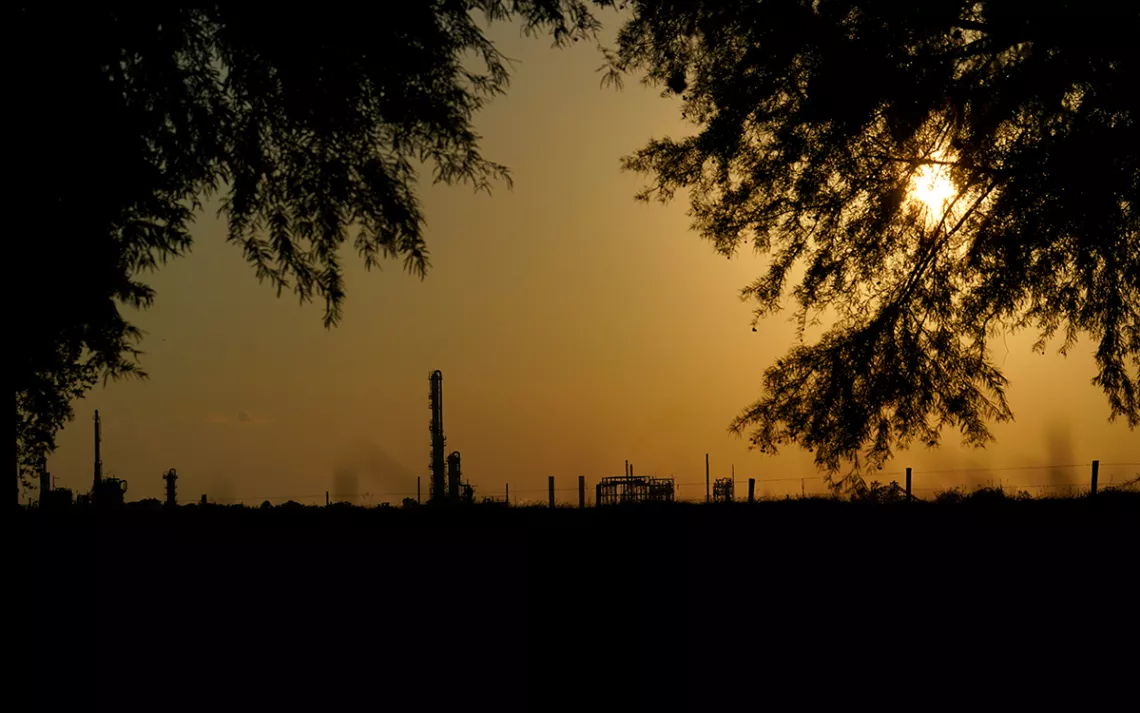From Plantations to Petrochemicals
The historical roots of Louisiana’s Cancer Alley can be found in slavery

A statue in front of a slave cabin at the Whitney Plantation in Edgard, Louisiana. When John Cummings purchased the property, he found volumes of documents related to the old sugar plantation’s labor force: people inventoried like cattle, women listed as breeding stock. “I was shocked to find that the second-most valuable asset was human beings,” he said. | Photo by Gerald Herbert/AP
Cancer Alley: That’s the infamous nickname for the heavy-industry corridor that stretches 85 miles from New Orleans to Baton Rouge, Louisiana. The zone along the Mississippi River is home to more than 150 petrochemical plants—from oil refineries to chemical and fertilizer manufacturers—that continuously emit toxic pollutants including carcinogens such as benzene. According to Kim Terrell, a research scientist at the Tulane Environmental Law Clinic, there is “strong evidence” that toxic air pollution contributes to Louisiana’s unfortunate status as the state with the second-highest cancer rate in the nation. Residents in Cancer Alley also suffer from other pollution-linked ailments, such as respiratory diseases.
The assault on the communities’ well-being, environmental justice advocates and public health experts say, is a direct result of systemic racism and the legacy of slavery.
“There is unequivocal scientific support that there are racial disparities in the pollution burden in Louisiana,” Terrell said. This stems from an economic and land use system that, over the generations, has transitioned from slave plantations to the site of petrochemical plants and other polluting facilities. Long before this zone was dubbed Cancer Alley, the area that includes St. James, St. Charles, and St. John the Baptist Parishes was called Plantation Country.

The Denka Performance Elastomer Plant in Reserve, Louisiana. Less than half a mile away from an elementary school, the plant, which is under scrutiny from federal officials, makes synthetic rubber, emitting chloroprene. | Photo by Gerald Herbert/AP
“Modern-day plants are literally in the footprints of these plantations,” said Joy Banner, co-director of community-based organization the Descendants Project. The organization, cofounded by Joy and her sister Jo, advocates for the Black communities and descendants of slaves in Louisiana’s river parishes. Had it not been for the clearing of the land hundreds of years ago for sugarcane plantations, the petrochemical industry today would not have the infrastructure or appropriate land conditions to be sited here, she said.
United Nations human rights experts noted the area’s roots in slavery in a 2021 report that called for a halt to any further industrialization in the area. “The African American descendants of the enslaved people who once worked the land are today the primary victims of deadly environmental pollution that these petrochemical plants in their neighborhoods have caused,” the UN human rights observers wrote.
Those petrochemical facilities are owned by large corporations that are perpetuating an economic system of extraction and exploitation, community members say.
“From New Orleans to Baton Rouge, we have been targeted by people with money and power,” said Gail LeBouef, founder of the community group Inclusive Louisiana. She herself has cancer and has started chemotherapy treatments.
In March, two community groups and a local Baptist church in St. James Parish filed a federal lawsuit against their local parish government over what the complaint describes as a “discriminatory and harmful land use system” rooted in slavery. The lawsuit accuses the parish of intentionally siting polluting facilities in the two majority Black districts, detailing how this pattern stems from the era of slavery. The plaintiffs are calling for a moratorium on the construction and permitting of new industrial facilities in the parish.
“Lacking the imagination to develop safer, smaller, and more durable forms of economic development, the Parish continues thus to trade in the health and safety of Black residents in exchange for the financial largess and tax benefits industrialization purportedly provides for the rest of the Parish,” the complaint argues.
“The Parish council needs to realize that we elected them to do a job,” said Pastor Harry Joseph of Mt. Triumph Baptist Church, one of the plaintiffs bringing the case. “They need to bring in the things that people of St. James Parish want, things that will inspire our young people to get involved in the community, like shops and small businesses, instead of bringing in these plants that are harming our communities.”
During a seminar on race and climate change held at Whitney Plantation last September, Banner explained that racism is “entrenched in this area’s development, where we’re just repeating a system that’s been there.” The petrochemical industries’ argument that they promote economic development and jobs traces back to the time of slavery, she said.
Ashley Rogers, executive director of Whitney Plantation, recalled the historical ties between petrochemicals and plantations. During the 20th century after the abolition of slavery, the area’s sugarcane plantations took up mechanical harvesting methods and adopted pesticides and fertilizers derived from oil. By the middle of the century, the petrochemical industry began taking over the land to repurpose it for their polluting operations. “International companies descended on the river parishes, buying up plantations for the purposes of further extraction on this land,” Rogers explained. “The descendants of enslaved people still living on and near plantations became the fence-line communities of this new industrial environment.”
Rogers said the drive to locate heavy industrial facilities in the area and the subsequent sickening of communities of color and the descendants of the enslaved is a vestige of the area’s brutal past. “It’s really clear to me that it’s a legacy of slavery,” she said. “Even if our business leaders and politicians don’t see it that way, I don’t know any other way to look at it.”
Today, Whitney Plantation operates as a museum. According to its website, it’s the “only former plantation site in Louisiana with an exclusive focus on slavery.” But during the 1990s, the historic plantation was almost turned into a chemical plant.
Formosa Chemicals and Fiber had intended to turn the site into a rayon manufacturing facility, Rogers explained during a tour of the plantation. After years of fierce community pushback, Formosa abandoned its plan and sold the property to the museum’s founder, John Cummings, who envisioned converting it into a museum focused on slavery. The museum opened in 2014.
Since then, Whitney Plantation has brought over half a million visitors into St. John Parish, Rogers said. The museum saw roughly 100,000 visitors annually before the onset of the Covid pandemic. This year, Rogers is projecting it will get 80,000 visitors. She said visitors “would spend more money in the parish if there was any [local] economic development around us.” The lack of local investment limits the community’s revenue potential and the employment opportunities, shackling it to outside corporate interests to supply most of the economic value.
But Whitney Plantation demonstrates that there are alternatives to this economic development model. “We are a job creator. I just finished three days of training with local women from the community,” Rogers said in a follow-up interview. “We have good benefits here and good pay, and I think there’s a lot of economic value we provide that has not seen a lot of investment.”
Joy Banner of the Descendants Project agrees. “[The Whitney Plantation] is very valuable for us as a community, education-wise, and also demonstrating what economic [development] should look like, where it doesn’t need to be heavy industrialization,” she said.
Rogers said that nearly all of the economic development that has existed in the area has been based on extraction. She sees a direct connection between the plantation system of the past and the heavy industrial development of the present. “These are businesses that are set up to enrich a small number of people at the expense of the deaths of a large number of people.”
 The Magazine of The Sierra Club
The Magazine of The Sierra Club



